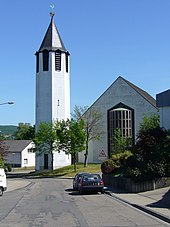Niederbieber
|
Niederbieber
City of Neuwied
Coordinates: 50 ° 27 ′ 34 " N , 7 ° 28 ′ 7" E
|
||
|---|---|---|
| Height : | 85 m above sea level NHN | |
| Residents : | 4747 (Jun 30, 2010) | |
| Incorporation : | 1910 | |
| Incorporated into: | Niederbieber- Segendorf | |
| Postal code : | 56567 | |
| Area code : | 02631 | |
|
Location of Niederbieber in Rhineland-Palatinate |
||
|
Niederbieber, aerial photo (2016)
|
||

Niederbieber is a district of Neuwied in Rhineland-Palatinate . Until 1910 Niederbieber was an independent municipality.
location
The district is located north of the city center at the confluence of the Aubach and Wied rivers . To the northeast of Niederbieber is the Oberbieber district, and the Irlich district to the southwest . Immediately adjacent are the Rodenbach district in the west and the Segendorf district in the northwest . Niederbieber is located on the edge of the Rhine-Westerwald Nature Park .
history
The earliest settlement remains of Niederbieber are around 13,000 years old. They come from hunter-collectors of the so-called penknife groups . The Niederbieber discovery site provided important insights into people's lives at the end of the Ice Age. Excavations and research in Niederbieber are carried out by the nearby Paleolithic research area of the Roman-Germanic Central Museum in Monrepos Castle . Excavations show that the site of today's Niederbieber was also inhabited by Romans and Teutons . It lay on the Roman Limes and was the site of Niederbieber Castle , which was built around 185 AD and destroyed by the Franks in 260 AD . Niederbieber was first mentioned in a document in 1204.
Niederbieber community
Niederbieber belonged to the parish court of Bieber and until 1806 to the county of Wied and from 1784 to the principality of Wied-Neuwied. In 1806 Niederbieber came to the Duchy of Nassau and in 1815 to the Kingdom of Prussia . Under the Prussian administration, Niederbieber became a municipality in the registrar's district of Neuwied , which belonged to the administrative district of Koblenz and from 1822 to the Rhine province and was administered by the mayor's office in Heddesdorf (renamed Amt Heddesdorf in 1927). In 1910 the municipalities of Niederbieber and Segendorf were merged to form the municipality of Niederbieber-Segendorf . After the Second World War, the administration of the Heddesdorf office was relocated to Niederbieber-Segendorf, in 1957 the Heddesdorf office was transferred to the Niederbieber-Segendorf office and later to the municipality of the same name .
In the course of the Rhineland-Palatinate territorial and administrative reform that began in the mid-1960s , the "Eighth State Law on Administrative Simplification in the State of Rhineland-Palatinate" of July 28, 1970, which came into force on November 7, 1970, changed the municipality of Niederbieber- Segendorf incorporated into the city of Neuwied. With the resolution of the Neuwied City Council on January 22, 1971, Niederbieber became a district which is represented by a local advisory board and a local councilor.
The double-towered gate wall in the former coat of arms indicates the Roman fort in Niederbieber, the beaver is a place-name reference and the base of the corrugated shield symbolizes the Aubach and the Wied .
Attractions
- Niederbieber Roman fort
Despite the later overbuilding of the site, the foundation walls of the Roman baths are now secured and give an impression of the imposing complex.

The late Romanesque church was built in the 13th century and was the local Catholic parish church until 1547. Structural details still suggest that there was veneration of the Virgin Mary. Archbishop of Cologne and reformer Hermann V von Wied, who died in Altwied Castle , was buried under the altar in 1552 .
- Old council and bakery, today the village museum
The village parish hall in 1736 served several purposes at the same time: town hall, schoolhouse and bakery. The town council met in the half-timbered upper floor with the bell tower, and the town baked its bread in the stone substructure until 1908. Most recently it was used as a residential building until 2005, after which it was bought by the Niederbieber Citizens Association (VNB) and converted into a village museum on a voluntary basis, which opened its doors in 2007.
- Earth times clock
On this work of art created by Alfred Hörchner with a diameter of 1.5 m, the development and process of our earth is shown analogous to the 24 hours of the day.
politics
Local advisory board
The local advisory council in Niederbieber consists of 8 council members, who were elected in the local elections on May 26, 2019 in a personalized proportional representation, and the honorary mayor as chairman.
The distribution of seats in the local advisory board:
| choice | CDU | SPD | FWG | WGS | total |
|---|---|---|---|---|---|
| 2019 | 2 | 5 | 1 | - | 8 seats |
| 2014 | 2 | 4th | - | 2 | 8 seats |
| 2009 | - | 5 | 3 | - | 8 seats |
- FWG = Free Voters' Group Neuwied e. V.
- WGS = Voter Group Siegel e. V.
Mayor
Karl Heinz Troß (SPD) has been the honorary mayor since 2019.
Individual evidence
- ^ Gelhausen 2011: F. Gelhausen, settlement pattern of all-time spring knife groups in Niederbieber, city of Neuwied. Monograph of the Roman-Germanic Central Museum Mainz 90 (Mainz 2011).
- ↑ Official municipality directory (= State Statistical Office of Rhineland-Palatinate [Hrsg.]: Statistical volumes . Volume 407 ). Bad Ems February 2016, p. 173 (PDF; 2.8 MB).
- ↑ a b Local election 2019 - election results. Retrieved June 24, 2019 .


